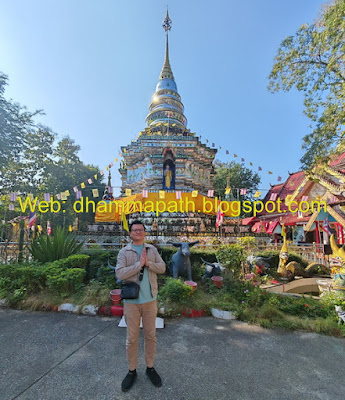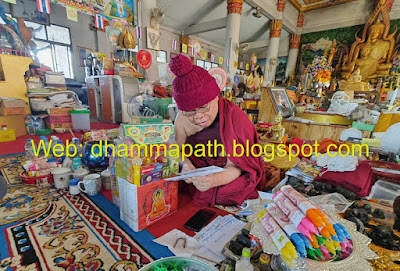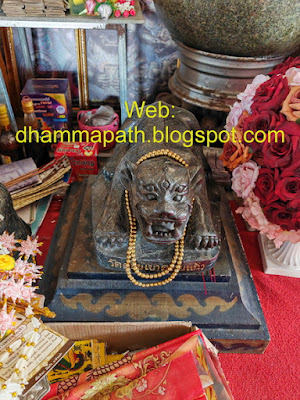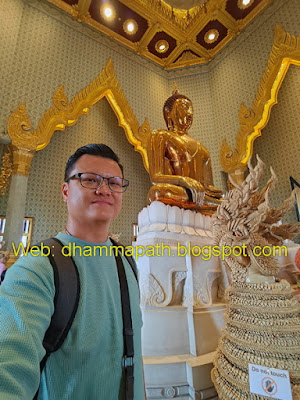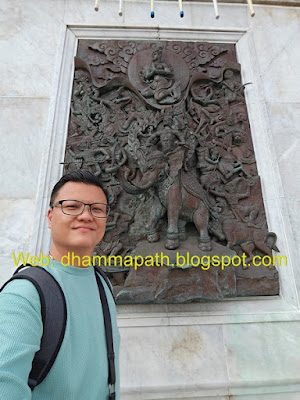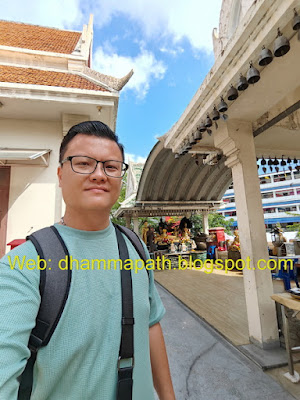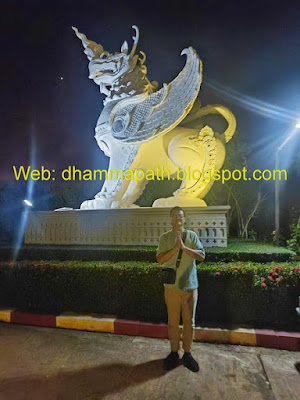Wat Phrathat Doi Khao Kwai is a hilltop temple in Chiang Rai that is associated with the story of SiHuHaTa, a local legendary creature with four ears and five eyes, that eats red-hot charcoal which it defecates as pure gold. This temple on the mountain where the historical & mythological Sihuhata was first found. Nice temple up the hill, the environment is great. You can see the Chiang Rai town from up there. I have opportunity to met up with Kruba Nong Sumano (PhraKru Suman Chetiyarak), make merit and asked for blessings. This part 1 we sharing photos with Kruba Nong Sumano.
The 'mirror' Chedi of Wat PhraThat Doi Khao Kwai enshrined the Relic of the Buddha ~ specifically a left little finger. According to information at the temple, it was King Kuena, the sixth ruler of the Mangrai dynasty, who began the construction of Wat Phra That Doi Khao Kwai. His reign lasted from 1355 to 1385. He brought a relic of the Buddha, specifically a left little finger, Wat Phra That Doi Khao Kwai to spread Buddhism in the region. Several restorations of the temple compound have taken place over time. King Kuena was a devout Buddhist and also founded Wat Phra That Doi Suthep in Chiang Mai. The 3 Gongs next to the Chedi Wat PhraThat Doi Khao Kwai.
The ancient Chedi Phrathat, the glass mirror attached to the Chedi is old and deteriorated over time. This sacred Chedi look classic and unique.
Brought Sangkatan for Kruba Nong Sumano during my visited. Sangkatan is a general term for offerings made to the Sangha (Buddhist monastic community). These offerings can include food, clothing, medicine, and other essential items. Behind banner photo is new batch Tao Wessuwan blessed by Kruba Nong Sumano.
Portrait of Kruba Nong Sumano ~ PhraKru Suman Chetiyarak, the current abbot of Wat PhraThat Doi Khao Kwai. On 19 Feb BE2566, Kruba Nong Sumano received 3rd ranks title with certificate of honor for his contributions of Buddhism Chiang Rai Provincial. This honor for outstanding performers Sangha in promoting and protecting Buddhism and also operations of Chiang Rai Protection and Protection Association.
Portrait of Kruba Nong Sumano ~ PhraKru Suman Chetiyarak, the current abbot of Wat PhraThat Doi Khao Kwai. On 19 Feb BE2566, Kruba Nong Sumano received 3rd ranks title with certificate of honor for his contributions of Buddhism Chiang Rai Provincial. This honor for outstanding performers Sangha in promoting and protecting Buddhism and also operations of Chiang Rai Protection and Protection Association.
Kruba Nong Sumano received the offering "Sangkatan" and do blessing for merit. It's a way for laypeople to accumulate merit (good karma) and dedicate it to the well-being of others, including deceased loved ones. The primary purpose is to accumulate merit, which is believed to bring positive results in this life and future lives. It's also a way to express gratitude and respect towards the monks and the Buddha's teachings.
The main altar very packed with all Holy items with no empty space.
The leftover candle wax is accumulated as mountain high on the candle bowl holder for temple ceremonies.
One of the old batch statue SiHuHaTa by Kruba Nong Sumano put on the altar here.
Statue of Phaya Yommarat in Wat PhraThat Doi Khao Kwai.
Obtained some SiHuHaTa from temple amulet counter.
Kruba Nong Sumano rebless all the Holy items. Of course for the most popular SiHuHaTa from origin temple here, Wat PhraThat Doi Khao Kwai.
Photo taken with Kruba Nong Sumano. He is very friendly in a quiet and serene way.
The main altar very packed with all Holy items with no empty space.
The leftover candle wax is accumulated as mountain high on the candle bowl holder for temple ceremonies.
One of the old batch statue SiHuHaTa by Kruba Nong Sumano put on the altar here.
Statue of Phaya Yommarat in Wat PhraThat Doi Khao Kwai.
Obtained some SiHuHaTa from temple amulet counter.
Kruba Nong Sumano rebless all the Holy items. Of course for the most popular SiHuHaTa from origin temple here, Wat PhraThat Doi Khao Kwai.
Photo taken with Kruba Nong Sumano. He is very friendly in a quiet and serene way.
Old part of temple building and Shrine for Phra SangKaChai and Laughing Buddha.
Temple is located on a hilltop with lush greenery surrounding mountains..
See more Kruba Nong Sumano & Wat PhraThat Doi Khao Kwai amulets at:
.
Or other amulets & Daily new posting at:

